
When you start to learn how to brew espresso, you get frustrated, and some even give up and they return to the mediocre shots at the famous coffee shop chain. This is understandable because making the perfect espresso is a complex, elaborated, sometimes intuitive combination of coffee quality, extraction pressure and time, water temperature, coffee grind, and roast, and more… If only one of these parameters is off, your espresso shot will be an average one.
Learn how to brew espresso at home, using an automatic or a manual espresso maker. Tips on pulling the perfect espresso shot and a troubleshooting guide.

Making Perfect Espresso: The Basics
As in all areas where talking about savor, aroma, and taste, preparing a good coffee needs strict rules. If you skimp on the quality of the beans, it will dramatically affect your espresso, a poor grinder will also have a bad effect on the end result, and let’s not forget the espresso machine that can make or break your shot.
But also, espresso requires preparation and tasting ritual, and some subjectivity. That means that the perfect espresso shot is subject to personal taste and mood.
Having said that, there are a few factors that are the common ground no matter what is your taste. Let’s see what are these factors and how can we control them for a perfect shot of espresso.
Home Espresso Making – Intended Audience
This is an advanced espresso brewing guide, and it assumes you have some knowledge of the subject. You can read it anyway because it provides you with facts that are useful regardless of your knowledge level. If you would rather take it gradually and start from the beginning, I recommend you to read our low-budget espresso-making page. It is a great starting point in your barista training journey.
We are not going to talk about Moka pot coffee here because, although technically an espresso, it is not the same as the coffee you get from a modern pump-driven espresso machine. We have a tutorial on How to Make Coffee with a Moka Pot, if that’s what you are looking for, and it’s a great advanced tutorial.
We are not going to talk about the French press either. You can brew French press into a stronger coffee, but you can do that as well with a drip coffee maker if you use a screen filter instead of a paper filter.

For those who need a refresher, this infographic shows the basic steps of brewing espresso.

The Perfect Shot
The perfect shot is a subjective term. Many people like ristretto, others prefer a lungo, and others like the normale. The Northern American coffee community has attached an objective description to espresso perfection. The description doesn’t take into account personal taste, it’s just an ideal extraction of the essence of coffee. This ideal shot is very hard to prepare, most people get it right once out of 5-7 shots. This perfect espresso is referred to as the God Shot, and it’s basically a double ristretto. For a detailed description, you can read this article by Mark Prince on CoffeeGeek.com.
Defining Espresso – What Is the Perfect Espresso Shot?
You heard someone saying: “This espresso is perfect”, but you don’t really have a comparison term, and maybe you didn’t even like it. Then the question is: “how do you know you have been served a good one?”.
If you brewed one yourself, which I hope you did, how do you know if your espresso is good?
Here are a few hints that will give you at least an idea of what it means “a good espresso”.
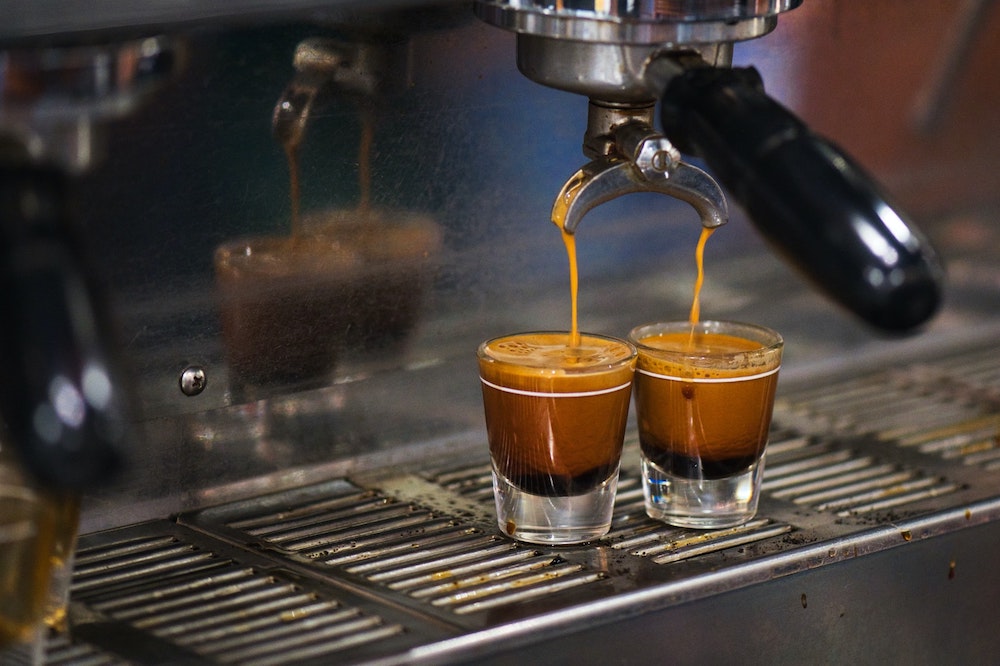
- It should have a consistent layer of the specific brown foam, called crema. Much of the specific taste of espresso resides in its crema, and it accompanies the dark extracted liquid through the end, leaving a unique combination.
- The taste is in a small measure dependent on the beans’ provenience, but more than that, it depends on the roasting art. Bitter is often associated with espresso, but that’s not what properly describes it. In fact, a Starbucks shot is bitter, but it is that way because the coffee is over-roast.
- Furthermore, a long shot tastes different than a regular one, and a ristretto is different as well. And they are not different because of the concentration, they are structurally different.
- The aroma of an espresso shot is so unique, it resembles somewhat the drip, or the Turkish coffee, or any type of coffee brew, but it is distinct, and you can easily tell espresso from other brew types only by its aroma.
We are saying this somewhere else in this article, “espresso taste is personal“. Some might like it chocolatey, others might like it balanced, some might like some earthy notes, or floral. An acidic espresso is not a problem, if the acidity comes from the beans. I love to pull shots from Kenyan beans. The wine-like acidity from Kenyan beans brings brightness in my espresso.
On the other hand, with under-extracted shots, sourness is all you can taste. So acidity is good, if you like some brightness in your cup, just make sure that what you taste is not under-extraction.
Interesting story on the crema. I was asked once by a home barista to help him improve his shot pulling skills. “What’s wrong with your shots?”, I asked. “They don’t have enough crema.” the answer came back. I then asked to see some of the shots. They were perfect. A thick layer of crema, a beautiful color, all visual signs of a great espresso. I couldn’t taste that because all of this was online, but he confirmed that the taste was great.
It turns out he was comparing his shots with the ones he saw online. What you see online is the result of skills, knowledge, hard work, research, and cheating. If you use Robusta beans exclusively, you will get a lot more crema. If you use a pressurized basket, you will get some more crema, but this time some of it “faux crema“. So don’t try to pull shots with half a cup crema, try to pull shots that you enjoy drinking.
The Perfect Espresso Recipe
“The perfect espresso” is a combination of the coffee beans’ quality, the espresso machine’s quality, and the barista’s skills. This is what makes up a great espresso shot:
- An espresso shot contains around 1 oz of brewed liquid and is made from 6 to 8 grams of ground coffee.
- A double shot, or a doppio, is prepared with 12-14 grams of grounds.
- The brewed coffee is a mixture of acids, proteins, sugars, aromatic oils, and other substances, in perfect concentration and proportion to enhance the aroma and taste to the maximum.
- The extraction is made by passing hot water – 190 to 202 °F (the espresso brewing temperature in Celsius is 88-94 °C) with a pressure of 9 bar, (8.88 atmosphere), through ground coffee.
- Coffee is placed in the portafilter and pressed with a special tool, (espresso tamper), with about 30 pounds force for that perfect stream of water to pass through the entire dose. If the coffee is too finely ground, the tamping should be lighter.
- Espresso is just great as it is, with no additions to it, besides maybe a little sugar, or a biscotti. But many people love it as a base for other coffee beverages, such as a latte, cappuccino, or macchiato.

Brewing Variables
Most coffee brewing methods play with these brewing variables: water temperature, brew time, grind size, the dose, and the yield (brew volume). When brewing espresso we ad another variable in the equation: pressure. It is the pressure that makes espresso stand apart from all other coffee beverages. The brewing pressure is a compound result of the dose, grind size and tamp.
Grind Size
Espresso is known for its fine grind size, typically a bit finer than table salt. I recommend you to own a decent burr grinder. This will ensure grind size consistency, which could make or break an espresso shot.
The finer you grind, the more pressure you create in the portafilter, hence the shot will pour slower. Too coarse the grind and the shot will pour too fast. The grind size is the variable that influences most consistently the pressure and indirectly the brew time.

Water Temperature
The SCA standard for coffee brewing is that water is around 195–205° F (90.5–96° C) at the time it hits the coffee bed. When brewing espresso, the extra variable changes the extraction. So you can go a few degrees lower if you like to experiment.
An espresso machine with a PID is the best investment since it will let you perfectly control the brewing temperature and have an insight into what the water temperature is during the shot pulling. A PID will also let you lower or increase the water temperature if you want to play with your recipe.
Brew Time
The brew time for espresso is between 24 and 30 seconds. The brew time is dictated by the grind size, dose, and tamp, with grind size being the most important.
If your shot takes longer than 30 seconds to pull there will be too much heat and the shot will be over extracted. This will be a burnt espresso shot.
If the shot pulls faster than that, coffee grounds will not have enough time to extract, and the shot will be under-extracted.
Dose
The dose is in theory the easiest to control, even though any new beans you buy need some re-calibrating. The best way to dose is using a scale. However, many home baristas use volumetric dose measurements, (using a scoop), and this leaves room for inaccuracy. So if you have the budget, make sure you buy a kitchen scale. This will also help to measure the brew volume.
The Tamp
The general consensus is that the tamp should never be played with, and should be around 30 pounds of pressure. I like to play with the tamp force sometimes, and I know I am not the only barista who does that.
Yield
For espresso, the brew ratio is measured as the ratio between coffee input and beverage output, which is a bit different than all other brewing methods. This brew ratio rages from 1:1.5 to 1:3. If the brew ratio is off, we will extract compounds that might not be desirable, and this will shift the flavor profile. For best accuracy, pulling a shot on the kitchen scale is the best. Again, volumetric measurements can only be approximations. The crema volume will make it difficult to accurately measure the yield.
The brew ratio will also dictate the beverage you are brewing: a normale, a lungo, or a ristretto.

The Perfect Espresso – Recipe and Preparation Tips
How to Brew Espresso Step by Step – The Basics
Espresso brewing is complex, but the simplest espresso recipe is this. For more details around each step, read this page thoroughly.
- Fill up your water reservoir with spring water.
- Turn on the espresso machine so it has time to warm up.
- Weigh your coffee beans on a kitchen scale. You need 14 grams of coffee grounds for a double shot.
- Grind your espresso beans finely. The ground coffee should be about the size of table salt.
- Fill your portafilter with the coffee grounds, and make sure you distribute it evenly to avoid channeling.
- Lightly tap the sides of the portafilter to achieve perfect distribution, or use a distribution tool.
- Tamp it with about 30 pounds of pressure, I explain more in this tamping tutorial.
- Insert the portafilter into the brew head of the espresso machine, and press the brew button.
- If the variables above are correct, you will get a doppio in about 25 seconds, give or take 5 seconds.
Espresso is above all a race against time. Prepare quickly, in just 30 seconds in which hot water passes through the ground coffee beans, at a certain pressure. Ideally, the barista serves the espresso fast and you drink it fast. Ten seconds after pulling the shot, the espresso taste begins to change and the change increases exponentially in time. The fact that the preparation is extremely fast, makes it even easier to miss the perfection. Here are some tips for preparing your best ever espresso:
- Buy coffee as fresh as possible.
- Always use freshly ground coffee, always.
- If you don’t buy an “espresso blend”, choose a “Full City Roast” or a “Vienna Roast”
- Pull the shot at the right temperature. Espresso is brewed at 195 °F to 205 °F, (90 °C – 96 °C).
- A regular, single shot is made with around 7-8 grams of ground coffee. You can play a bit with this but start with the standard to get a decent shot, and then experiment your way to greatness.
- The brew ratio for espresso is 1:2 up to just under 1:3. If you use 14 grams of ground coffee you should stop the shot when you have 30 grams of liquid.
- In order to get that ratio, the shot pulling should last 20 to 30 seconds, depending on your taste and the grind size.
- If pulling the shot takes too long, the heat from the water will accumulate, and by the end of the shot your coffee will be burnt. This will be a bitter shot
- If pulling the shot is too fast, the contact between grounds and water will be too short, and the extraction will be incomplete. This will be a sour shot.
- Tamp with around 20 lb to 30 lb pressure. As a beginner, you can tamp on top of a scale, in time you’ll get the feeling of it. Check the video below to see how to set up your practicing bench. Or if you want precision every time, look at the Espro Calibrated Tamper.
- The grind should be espresso grind size, and it dictates the tamping force. The finer the grind the lighter the tamping. But this is only if you want to play around. Most baristas will keep the tamping at 30 lb pressure and adjust the grind until they find the sweet spot.
- Buy a specialized espresso blend, if you are a beginner, it’s safer.
How To Choose the Espresso Beans
Buy coffee as fresh as possible. This is the most important for espresso. Crema is made of CO2, coffee oils, and water. Coffee oils, water, and CO2 are emulsified during the extraction so that the oils and the CO2 form the thin crema layer at the top of the shot. When coffee is old, it loses the two main ingredients in crema – oils and gasses. The older the coffee beans, the less oil and gasses are in the coffee. This is why you should never buy ground coffee, and freshly grind your beans just before pulling the shot. Buy coffee properly stored, or freshly roasted.

Can Espresso Be Made from Any Coffee Beans?
In theory, you can use any coffee beans to make espresso. Espresso is not a coffee bean, or a roast, it is a coffee brewing method. In reality, there is more to it than that. For instance, a darker roast is easier to extract, because the bean’s cell structure is softened up with the prolonged roast. A lighter roast will provide better coffee, and the espresso will retain a lot more of the beans’ origin, but it is harder to pull, and requires more precision.
Another aspect to consider is the beans’ origin. For instance, many Brazilian beans are great for espresso because they produce a lot of crema. Too much acidity in an espresso is generally perceived as a flaw, although some, (including me), might enjoy them.
When choosing your coffee, you can’t go wrong with Brazilians. If you buy espresso marketed beans, you will be sure you bought good coffee. You can’t go wrong with Illy, but is more expensive. Make sure your espresso blend is from a reputable roaster. Sometimes roasters add too much Robusta in their blend, in order to improve crema. Robusta beans tend to have burnt rubber taste.
If you don’t buy an “espresso blend”, choose a “Full City Roast” or a “Vienna Roast” more about coffee roast.

What Not To Do When Brewing Espresso: Troubleshooting
There are other countless ways to fail an espresso. In the first five seconds pre-infusion occurs, the contact between water and the ground coffee, and then in the next 25 seconds follows the actual infusion – the espresso pull.
The 25 seconds of infusion is the time when the flavors and aromas are poured into the cup. A too-short pulling time results in a very short espresso with low volume and an acid taste. If the pull is too long, the coffee will be bitter and will mask all of the coffee flavors, and the shot will contain more caffeine. At the end of the pull, the foam turns brown in color, and this foam contains the highest concentration of caffeine. This foam, (la crema), must be dense and thick. Air bubbles or white spots are signs of poor preparation.
In your quest of preparing a “barista grade” espresso, you need to know the nine potential problems that could render your shot bland or bad:
1. Coffee is oxidized, (stale)
Your ground coffee had contact with the air more than 4 hours before use.
2. Incorrect Tamp
The coffee tamping is too mild or too hard, or uneven; Make sure you distribute the grounds evenly in your portafilter by running your index across the coffee bed surface. Flatten the mound by distributing the grounds to the edges of the portafillter.
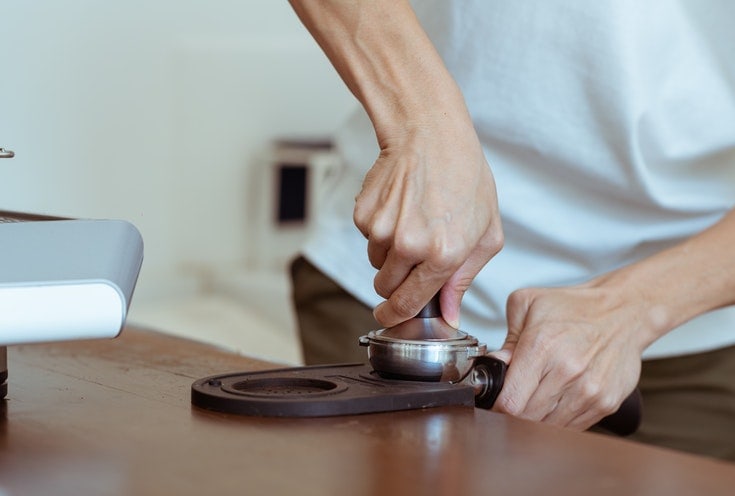
3. Inadequate Shot Extraction Time
Extraction time is too short or too long; If extraction is too long you will get a bitter coffee, if it’s too short you will get sour coffee.
4. Poor Maintenance
Poor maintenance of the device (you have to clean and descale on a regular basis).
5. Wrong Grind Size
Coffee grind is either too fine or too coarse.

6. Poor Quality Coffee Beans
We are not talking about an incorrect roast or stale coffee here. We are talking about poor quality coffee beans. Coffee picked unripe or processed incorrectly, or just a poor quality variety.
7. Water Quality
If you use bad-tasting water, all of that bad taste will be transferred into your cup. Some people think that the brew will mask that bad taste of the water, but in the end, your coffee will just taste bad. Use fresh and clean water, and if the tap water tastes bad, buy bottled water for your coffee.
8. Cold Cups, or Cold Equipment
All espresso machines need to be warmed up before pulling a shot. You should run a blank shot before starting to brew espresso. If the brew head is cold, the water will cool down in its way to the coffee puck, so the extraction will be affected. A cold cup will immediately cool down your tiny beverage. If your machine doesn’t have a cup warmer, you can warm up the cups with hot water just before pouring the shot.
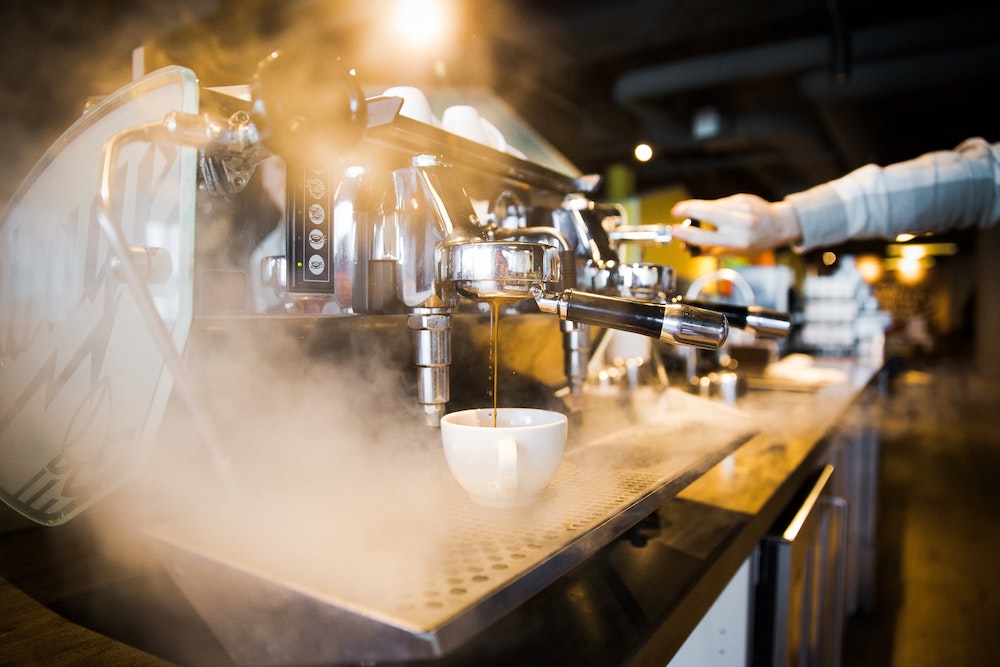
9. Poor Equipment
There are also problems that you can’t control, related to the equipment. You can’t change these after you bought a bad espresso machine, but you can choose carefully your next one.
- Inadequate pressure, too low or too high, (best machines have a PID)
- Water temperature is not consistent

Your Perfect Espresso Shot is a Bit Personal
Normale vs Lungo vs. Ristretto vs. Americano – A Matter of Taste
The perfect espresso is many times a matter of personal taste. Many times, what a barista considers a perfect espresso, is not working for you.
I will give you the example of Starbucks espresso; for any coffee connoisseur, their espresso is too bitter because of the excessive bean roast. They still have a constant stream of people who just love their espresso. So, don’t let anybody tell you what is the best espresso for you. Experiment with various beans, various extraction times until you get your espresso right for you.
Personalize It
A few variations of the taste and strength can be obtained through the control of the extraction time. The standard espresso shot is called “normale“, and it is about 1 fl oz. A slightly longer extraction time will produce a “lungo“, which is less concentrated but will contain more caffeine.
If you prolong the extraction time even more, you will obtain the “caffè crema”, which is a longer espresso, (longer than lungo), and has the taste of the espresso, but is milder, and it has a bit more caffeine.
“Caffè americano“ is similar to a long shot, but is obtained by pulling a long shot, and adding a shot of hot water. The americano It has the strength of a “caffè crema“ but it is different because it maintains the espresso flavor profile, but diluted.
Using a short extraction time, you will obtain the “ristretto“, a short espresso. Ristretto contains less caffeine but more flavors and aromatic oils. If your espresso machine has the capability, you could prepare the ristretto by shortening the extraction time but pushing the same amount of water through the coffee grinds. The result will be similar, but you will have more coffee in your cup. Ristretto is less bitter than normal, (regular espresso), and is more flavorful.
How to Serve and Drink an Espresso
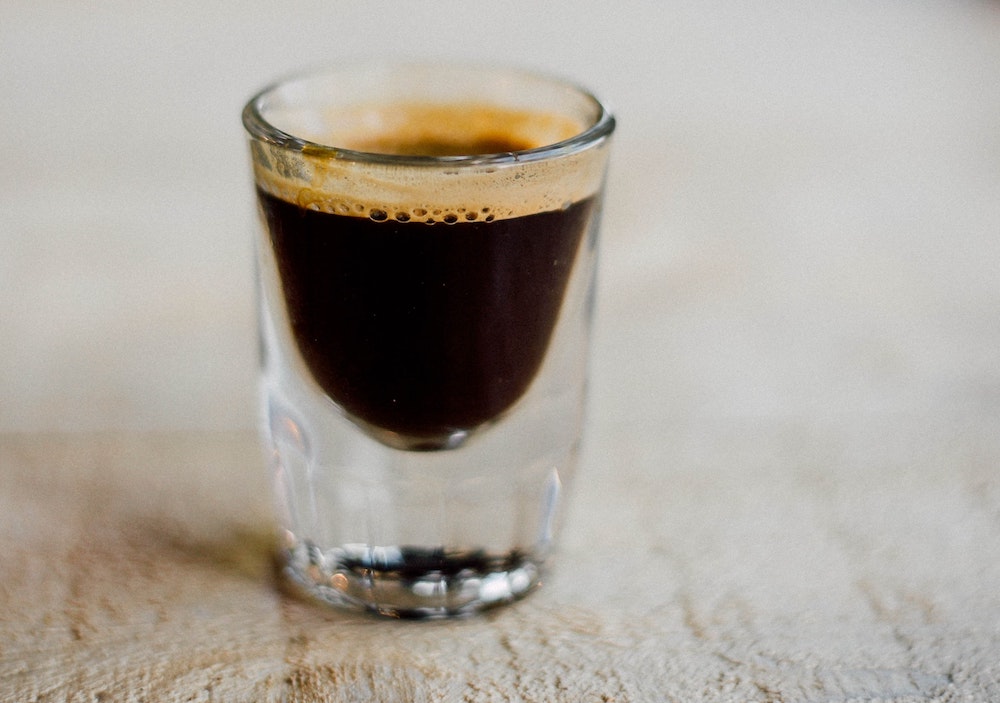
Tips to Enhance your Espresso Experience
Serving and drinking espresso is part of a ritual that makes up the whole espresso experience. You need to focus on every detail of the process to enjoy the flavors to the maximum. Here are a few hints.
Porcelain espresso cups maintain optimal coffee temperature for a longer period and maintain the foam and the flavor. There are also glass cups with a double wall that are even better than the porcelain ones, and they look fancier. For optimum results, the cups need to be warmed up before pulling the shot. Oh, by the way, you also need to warm up the portafilter before using it.
Drink Mineral Water with Your Espresso
Drink a few sips of water before your espresso; this will help your taste buds to wipe any previous taste memories. You can also drink water in between your espresso sips. Coffee dehydrates, and you need to drink water.
Espresso is a strong coffee and while is very tasty and bold, for some it is hard on the stomach. A little water between sips won’t dilute the taste but will dilute its strength in the stomach. Drinking water cleanses the palate, so you can drink before taking the first sip, and you can drink it in between sips.
Mineral water (sparkling water), is the best because carbonated water neutralizes better lingering flavors in your mouth.
I typically end this routine with a sip of espresso, because I want the exquisite taste to linger a little longer. Sometimes though, I choose to end with water, so I can wash off the taste of a poorly prepared shot.
Cookies and Espresso
Mix a bit in your espresso before the first sip, even if you don’t add sugar, this will ensure that the first drink is not a bitter one. Some add sugar to their espresso, others eat a biscotti or any other cookies with their espresso, others will just drink it as it is, plain. The cookie’s sweetness will contrast with the espresso’s bitterness in a good way, accentuating it.
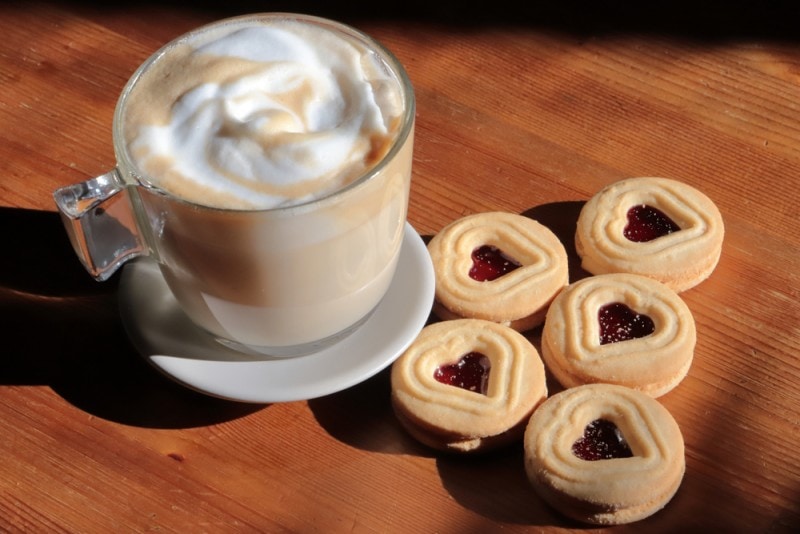
Is There Such a Thing as a Dead Espresso?
If you heard the term dead espresso and you want to know if it’s a real thing, here is the answer: YES and NO. You might be thinking now: “Very useful Dorian, thanks for sharing this…” OK, let’s delve a little deeper into it, and I’ll explain.
The term dead espresso as it was coined by certain corporate barista circles, means a shot that is older than 10 seconds. When I pull my espresso shot, it needs a few seconds to cool of. Coffee should not be consumed piping hot because you can’t really taste it anymore. So this means that my shot is dead before it even reaches the drinking temperature. You see why this is silly?
On the other hand, a shot that has been sitting for 30 seconds, loses all of its crema. (Rather crema is incorporated into your coffee.) So from an aesthetics perspective, the shot will be dead. However, when I pull myself a triple shot, I drink that over a longer period of time. My espresso will eventually get cold, and I enjoy it. Is it dead? Not to me. However, I have a longer discussion in a separate article about dead espresso shots, and why the discussion is a bit irrelevant. But, I admit, not entirely. Check my article, though.
How Does a Good Espresso Taste?
A properly prepared espresso is vaguely fruity, floral, slightly sweet, reminiscent of chocolate and caramel tones. Bitterness is a quality sign only if it’s gently weighted by a little acidity.
Read More: 5 Secrets to Improve Your Coffee Brewing Skills
Featured image credit: Free-Photos, Pixabay















